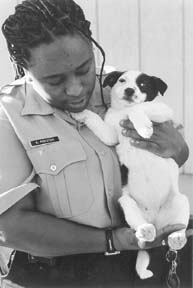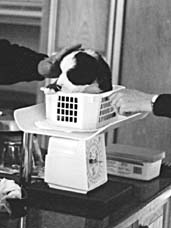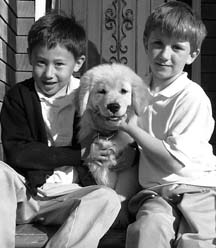Maybe I am what my wife calls me: a grumpy old man. I know that her assessment of me is close to right whenever I see a litter of puppies – admittedly so cute, so precious, so darling – and the first thing that comes to my mind is “Think ahead!”
There is simply no phase of a dog’s life that demands more preparation than when our cute little puppies are making the transition from a life in the womb to a life of personal independence and social interdependence with the family of man.

Responsible, holistic puppy care begins long before the puppy arrives at the homestead. In fact, the first step to creating a healthy puppy is the selection of the puppy’s parents! The best predictors of long-term health of puppies are the health history and personality of the parents. Breeding stock should be proven to be sound in body, mind, and socialization.
The next step has to do with the care and feeding of the mother, which has a huge impact on her puppies’ health. If your family will be a part of the dam’s pregnancy and whelping, your preparations should actually begin long before she is bred. By strengthening the mom’s organ-system and immune-system functions, you will help ensure that she is able to “build” uncompromised, healthy puppies.
In the womb
After fertilization, the eggs spend several days migrating from the oviducts and forming firm attachments to the wall of the uterus. Fertilized eggs that attach to the middle portions of the uterine horns are in the best position to receive the dam’s transferred nutrients; larger and healthier placental attachments provide better nourishment for the developing puppies.
Puppy development in the uterus is rapid. During the first two weeks the embryonic cells differentiate into all the cells that will be needed for the body’s development. At about two weeks of age the fetus is tiny, but has a head, spine, limb buds, and tail. At this stage it is still being nourished by the yolk sac, an attachment to the fetus that develops from the ovum. This early time is the most critical stage of development; any drugs or diseases in the mother now can severely damage the fetuses.
By the end of three weeks, all of the tissues and organs necessary for life have developed. At about three weeks the fetuses can be felt if the mother is reasonably thin.
By day 35 after fertilization, all of the puppy’s body characteristics are apparent. By day 40 the eyelids, claws, hair, and skin color are visible, and the puppies’ skulls can be felt through the mother’s abdominal wall. At 42 to 45 days of fetal age the pups have the form of miniature dogs, and their skeletons can be seen on X-rays. From this time until birth, three weeks later, the fetuses simply continue to grow.

Most pregnancies last 62 to 65 days, but there is considerable variation. Large litters often have shorter gestation (perhaps 57 days or even shorter), whereas small litters may not be delivered until 67 to 68 days (or more) into gestation.
A certain amount of emotional development also occurs during gestation. We know that human infants are influenced in the womb by their mothers’ personalities and lifestyles. I’m not sure that we need to chant calming mantras throughout our dog’s pregnancy (although it can’t hurt!), but I am convinced that puppies born into a calm and nurturing household typically end up being calm and healthy themselves.
Vaccination
Whether or not to vaccinate is a delicate subject for holistic-minded caretakers, and the question of vaccinating during pregnancy is even more controversial. We want the mother to pass the maximal possible level of antibodies against common diseases to her puppies, and vaccinations are one way of assuring this.
As a general rule, modified live virus (MLV) vaccines are contraindicated during pregnancy, but some veterinarians believe that many of the killed vaccines are relatively safe to give during the last few weeks of pregnancy. By giving appropriate vaccines about two weeks before whelping, they argue, we assure that the maximal amount of vaccine-produced antibody will be present to be passed on to the pups. However, killed vaccines typically yield the highest percentage of allergic reactions.
Another argument against vaccinating the mother during pregnancy is that, since her immune system has been altered to allow for the presence of developing puppies (which are actually foreign bodies of a sort), gestation is a time of maximal immune compromise – and vaccines given then may not be effective. Vaccinating a female when she is in heat may also prevent the vaccine from being fully effective.
As a holistic practitioner, I like to see puppies adequately vaccinated against the predominant diseases when they are puppies. Immune-competent dogs will develop all the immune-ability they are capable of with these early vaccines, so once titer tests confirm the pup’s antibody response to the vaccine is adequate, I don’t feel further vaccines are necessary.
Once again, for breeding stock, the most important thing is to know the history of the parental stock and to know whether they have been reasonably disease-resistant in their lifetimes. When in doubt, vaccine titers should be used to evaluate the breeding dog’s immune status before she comes into season or is bred.
Internal parasites
Internal parasites are another concern during pregnancy, as much for the human children that may handle the puppies as for the puppies and their mother.
The larvae of the roundworm (Toxocara canis) lie latent in the mother until around the 42nd day of gestation. Then, when the mother’s natural immune system is suppressed by hormonal changes, the larvae cross the placenta into the puppies, most of them setting up residence in the puppies’ livers. Some larvae also migrate to the mother’s mammary glands, and these can be passed to the puppies through her milk.

Dogs can also be infected by consuming eggs from the soil in the environment (generally through normal grooming) or by consuming a prey animal (usually a rodent) that is carrying developing worms. Larvae can live in the soil for months.
Ancylostoma caninum is the most common hookworm of dogs (and cats) in the northern hemisphere. Hookworms suck blood from the intestinal wall and are considered the most pathogenic (harmful) parasitic infection of young dogs. Severe infestations can lead to profound anemia and death in puppies.
Most dogs are infected initially by oral contact with larvae, which crawl out of infected feces and move to the surface of the soil or vegetation. Puppies can also become infected by ingesting the milk of infected mothers. Larvae can live in the soil for months – a continuing source of infection.
Humans are not a normal host of the canine hookworm, but on contact with infective larvae, they can develop a condition called creeping eruption or cutaneous larva migrans (itchy skin). Almost all puppies (experts estimate 90 to 100 percent) are born with roundworms and/or hookworms, or will be infested with them shortly after birth, even if the mother has tested negative for worms. (Detection during pregnancy is nearly impossible for several reasons.) With this in mind (and considering the potential for infecting children who will come into contact with the puppies), some vets recommend de-worming the mother several times during her pregnancy and de-worming the puppies several times, beginning about 3 or 4 weeks after birth.
Whelping
Unless you want the newborn pups to arrive on your new satin bedspread, construct a whelping box a few weeks before the pups are due, and get Momma Dog accustomed to using it. Position it in a quiet, secluded, draft-free place. Line the floor of the box with a thick layer of newspapers, cover this with a warm layer of heavy towels or a mattress pad, and provide a heat source that will produce 85° to 90°F at floor level. Make sure there is adequate space in the whelping box for mother and pups to escape from the heat if they want to.
A whelping box for a large dog can be about four to five feet square; a smaller dog’s box can be about two to three feet square. One side is low so the mother can easily get out; barriers are also put in place to enable the pups to get away from their mother when they need to.
Prepare family members for their potential role of cleaning and drying the arriving pups, but make sure everyone understands that most mothers will simply want to be left alone. In fact, a whelping female can stop the birth process until gawkers (or, in the wild, predators) leave the area.
The female about to give birth may become nervous up to 36 hours before parturition (“parturition,” the act of giving birth, is from the Latin parturire, to have the pains of labor). She may pace, appear anxious, and try to build a nest or dig a hole in the ground. She also stops eating and may shiver or even vomit. Hormonal influences usually cause the mother’s temperature to drop to less than 99° F within about 24 hours of the onset of parturition. There is a normal sequence of events that will occur during the birthing process, and whelp-ologists divide these into three stages. Stage I, cervical dilation, is marked by uterine contractions that are due to an increase in estrogen, accompanied by a decrease in progesterone and pressure against the cervix. The dam will be restless, turning around in circles and panting; she may also vomit. All signs increase in frequency and intensity for up to 12 hours as this stage progresses. She will then alternate between Stage II, expulsion of the fetuses, and Stage III, expulsion of placentas. After delivering a pup, the mother licks the membrane off the pup and severs the umbilical cord with her teeth. (Mothers that have a dental structure where the teeth don’t meet may not be able to chew the cords – yet another reason to look at her physical characteristics before you have her bred.) Within 5 to 15 minutes after each pup is born, its placenta is passed. It is normal, but not necessary, for the mother to eat the placentas – although she may vomit if she eats more than one or two.
Pups are typically born every 30 to 60 minutes. They may be delivered head first (about 60 percent are delivered this way) or tail first; either way is considered normal. The birth of the first pup should occur within four hours after the mother is in strong labor, and the normal interval between pups only rarely goes beyond two hours. Veterinary assistance may be required if these basic time lines are exceeded.
If the mother ignores the pup or doesn’t clean it, you may need to assist in the process. Tear the placental membrane and remove it from the puppy’s head and nostrils. Gently suck (a large-sized syringe is a good tool here) and swab fluid from the mouth and opening of throat, and then gently swing the puppy headfirst in a downward path while supporting its head and trunk in a dry, warm towel. If respirations don’t begin spontaneously, the pup may need chest and facial massage with a dry warm towel.
To encourage breathing, stimulate the acupuncture point Governing Vessel 26. GV 26 is located on the midline of the nose, on the upper lip just below the nostril openings. This point is an acute emergency point – good for treating shock, anoxia (lack of oxygen), cardiac arrest, or collapse. The point can be stimulated with anything sharp at hand: the point of a knitting needle, the nail of your index finger, or an acupuncture needle, if you happen to have one. Newborn puppies are not equipped with a great thermoregulatory system, so they need to be kept warm and dry. Usually a 25 watt bulb hung over the whelping box will provide enough heat. During the first week, the temperature under the heat lamp should be about 85° to 90°F. This should gradually be decreased to about 75°F over the next three weeks. If a mother leaves her pups for half an hour in a typical room temperature of 72° F, their normal body temperature of 100°F drops to a chilling 94 to 95°F.
Colostrum is a specialized milk the mother provides for a short amount of time after giving birth. It is rich in nutrients, but most importantly it supplies protective antibodies to the puppies. Since a puppy’s immune system does not develop until several weeks after birth, the pup relies on its mother’s antibodies for whatever immune-capability it will have. About 80 percent of the immune-capability that the puppy receives is from colostrum; the remaining 20 percent is passed through the placenta during pregnancy. It is thus absolutely critical that puppies receive the colostrum within hours after birth; production of colostrum occurs only shortly after birth, and a puppy’s digestive system is set up to absorb it for only a short time.
Shortly after whelping, the mother will gather all the pups to her and feed them. This is a good time to observe general health; a newborn pup may look and move like an amoeba, but it should actively seek a teat to suck. Once there, the pup should be able to latch on and suck strongly.
After the first feeding is a good time to give the puppies their first exam. All pups in the litter should be approximately the same size. An unusually small puppy may be an indication that it has some sort of genetic defect. The runt of the litter may require supplemental feeding for normal development. Even though they are tiny creatures, pups should have a sturdy feel of substance about them. They should have an active sucking reflex; and they should not persistently cry or whine.
If the mother refuses to feed the litter (or one member of the litter), or if she is not providing enough milk (indicated by persistently crying puppies), you may need to provide supplemental feedings. Commercial milk substitutes are available; check with your vet.
Birth to weaning
From birth to weaning can be the most enjoyable time of all because the mother will do most of the work, including the feeding and cleaning up the puppies’ feces – so long as she is given enough fuel to get the task done. You have three main jobs: a) monitor the pups to see that they are growing normally; b) give the nursing mother plenty of good-quality nutrients (to feed the litter the bitch may require more than 150 percent of the nutrients she needed for herself); and, c) make sure that all the pups get handled on a many-times-a-day basis.
A puppy’s eyes are shut and her ears are sealed at birth; they begin to open at 10 to 16 days of age. By 28 days, a pup’s vision and hearing are almost as good as an adult’s. Pups can sit up at two weeks of age and stand at three weeks. Pain sensation is present at birth, but it may take several seconds for pain to register with the brain. By three weeks, a pup registers pain as quickly as an adult dog. The growth rate of puppies varies widely, depending on the size of the dog. Birth weights can multiply more than tenfold within the first seven to eight weeks, and energy needs are about twice that of adult dogs the same size.
Smaller-breed puppies have a higher metabolic rate per pound and reach maturity quickly; medium-breed puppies grow at a moderate rate. By the time he reaches adult size, a smaller-breed dog may have multiplied his birth weight 25 times; a larger dog’s weight may have increased 100 times. Large- and giant-breed puppies normally grow at a slower rate. If we attempt to speed this rate (by feeding a diet containing excess calcium or other nutrients, as the most common example), the puppies are more vulnerable to developmental diseases of the skeletal system.
While physical aspects of the growing puppy are important, equally important is his social development. The mother will have a primary impact on her puppies’ early social skills. She controls puppy behavior by licking, nipping, growling, biting, and leaving the vicinity. The amount of control the mother exerts early on will help to mold the pup’s personality as it develops into an adult. Good mothering skills will show the puppy what is expected without applying corrections too aggressively. If the mother is too aggressive, the pup may grow into a dog that is less active socially; such dogs also tend to perform poorly on tests of mental ability. Human contact is also crucial during the growing phase and social development. Exposing the puppies to an enriched environment is important. As they mature, frequently taking them away from the mother to areas that offer a safe, slow, but ever-increasing amount of mental stimulation will also prove valuable.
Weaning is a natural and gradual process that mother dogs have been doing for eons. Our job is to provide food for the puppies. Beginning at about three to four weeks of age, mix up a watery gruel of the puppies’ food, and let them nose into it. You may need to encourage some of the pups. As they all get the idea, you can gradually decrease the fluid in the food.
Weaning should be complete by six to eight weeks of age, and puppies will be ready for a new home at eight weeks. Both of these are critical time frames. Pups should stay with the litters and their mother until they are at least eight weeks old; the primary time for learning socialization skills from their mother occurs when the pups are between six and eight weeks old. About eight weeks of age is the perfect time to be totally weaned away from mother and move on to another home. If a pup stays with the mother and litter past 10 to 12 weeks of age, it becomes more difficult to socialize to the family of humans.
Of course, we can’t always control the factors that will go into producing the healthiest puppies (although, I might argue, we can try, by planning to purchase a puppy from a breeder who can prove she has taken care of all of the above!). For many of us, those factors are out of our control – like when we adopt a puppy from a shelter. Even so, there is still much we can do to help assure that the puppy we intend to make a part of our family reaches his or her potential.
Acquiring a puppy
Preparations for a puppy’s arrival will support your training efforts and his long-term health. For starters, don’t choose on impulse; give some thought to the selection process. The cute little bundle of fur will be with you for 10 to 15 years or more. Be realistic about the type of dog that will fit into your family environment.
If at all possible, get a puppy that a) you can socialize, or b) has already been well-socialized. There’s only a small window of time during which a puppy is most accepting of new people and experiences: from 8 to 12 weeks. Puppies who were sequestered throughout that period usually grow into fearful adults.
Your puppy-to-be should pass your own physical exam. Pups should have bright eyes, a shiny coat, and they should move easily with no limps or gimps. Compare one pup to others in the litter and check for symmetry of body parts. A healthy pup will feel substantial when you pick it up, squirm a bit, and eventually relax in your hands. Make sure your purchase is contingent on veterinarian approval, and take the pup immediately to your vet for a final check.
Things that can go wrong
Most puppies are raised to weaning without any major problems. However, sometimes things do go wrong.
Although most whelpings go without a hitch, it is a time of stress, and things can go wrong. Hypoxia (reduced oxygen supply) or lack of proper nutrition are the most common causes of death in neonates (newly born), and these two factors are compounded if the pups become chilled or wet.
Studies show that about 17 percent of puppies die before weaning, but after weaning the rate falls to 4 percent. Most of the puppy losses (56 percent) occur during the first week of life; there is another mortality peak at weaning. Thus, the puppy’s first week is the most critical, and it is the time to monitor progress of all the litter members closely. Experienced breeders identify puppies with special neonate collars, and weigh each individual daily. If any of the puppies seem to be failing to thrive, the mom and the entire litter should be seen by a veterinarian as soon as possible.
Bacterial infections (neonatal sepsis) are more common in puppies with parasites, those who were not kept warm enough, failed to receive adequate nutrients from the dam, or were born with defects of the immune system. A variety of “bugs” may be responsible; usually gram negative bacteria predominate. Affected pups may have an unusual clinical presentation or signs may be virtually absent. They often cry and become restless and weak, or develop hypothermia or diarrhea. Failure to thrive is a common symptom, but may be difficult to assess without further testing, including at least a CBC and possibly other tests. Treatment consists of warming the puppies, fluid therapy if necessary, and antimicrobial therapy. This is one time when the big guns of Western medicine are indicated.
No matter what therapy is used – natural medicines or conventional drugs – it is important to note that drug/biochemical distribution in puppies younger than five weeks old is different from adults. Compared to adults, puppies have a lower total body fat, a higher percentage of total body water, lower concentration of albumin, and a poorly developed blood-brain barrier. Dosages need to be reduced by 30-50 percent of adult dose and/or the frequency of administration will need to be changed. Most drugs ingested by the mother will appear in her milk, but generally only at about 1 to 2 percent of her dosage.
Malnourished puppies are smaller, lighter, exhibit feeble attempts to suck, and/or are not attaining the expected weight gain for their age. High-pitched, constant crying or inactivity with an accompanying weak sucking reflex are advanced indications of malnourishment. When you handle these puppies you may also be able to detect reduced body tone and muscle strength.
These puppies often respond well to added nourishment. Commercial milk replacers are available, and the pups can be fed using a feeding tube or small baby bottle. As a rule, extremely weak puppies, those without a sucking reflex, or pups with a body temperature under 95°F do not have good survival rates, no matter the effort expended.
Puppy hypoglycemia is an idiopathic syndrome in toy breeds of dogs that is seen in the first six months of life. It seems to correspond with a relative immaturity of the liver, but can usually be managed by providing frequent meals of a commercial puppy diet. The problem usually resolves as the animal matures.
Fading puppy syndrome is actually a catch-all, descriptive term that includes many or all of the diseases that cause a puppy to fade or not thrive.
As the dog moves from puppy to adolescent, we humans become more and more involved in its healthy progression through life. The pup’s developing immune system is now ready to be stimulated in specific ways; vaccines and wormers will have to be considered; he will have to adapt to new routines and new foods; and he needs to become house trained and further socialized to other people and animals – all within a very short few weeks.
Dr. Randy Kidd earned his DVM degree from Ohio State University and his PhD in Pathology/Clinical Pathology from Kansas State University. A past president of the American Holistic Veterinary Medical Association, he’s author of Dr. Kidd’s Guide to Herbal Dog Care and Dr. Kidd’s Guide to Herbal Cat Care.





